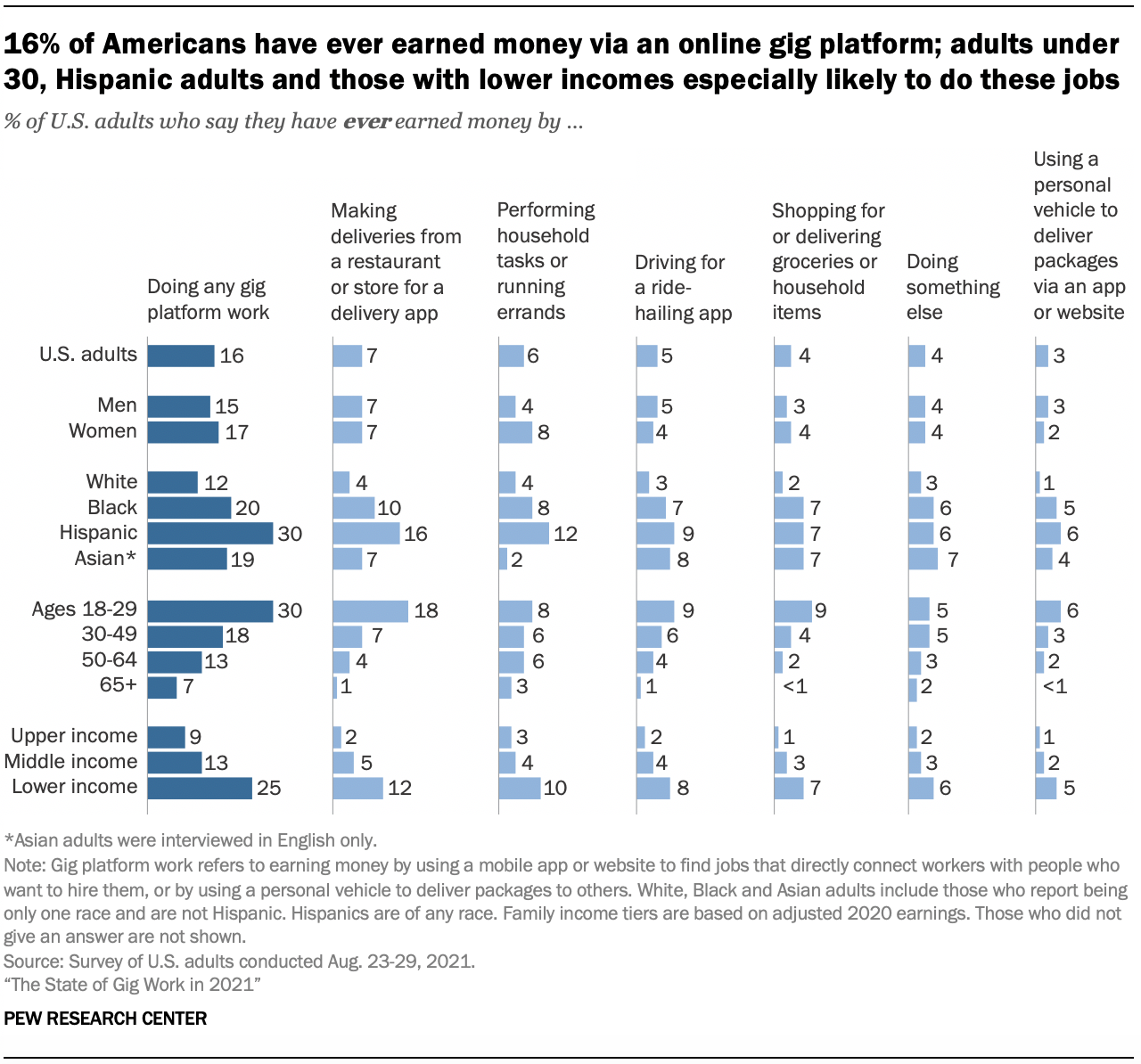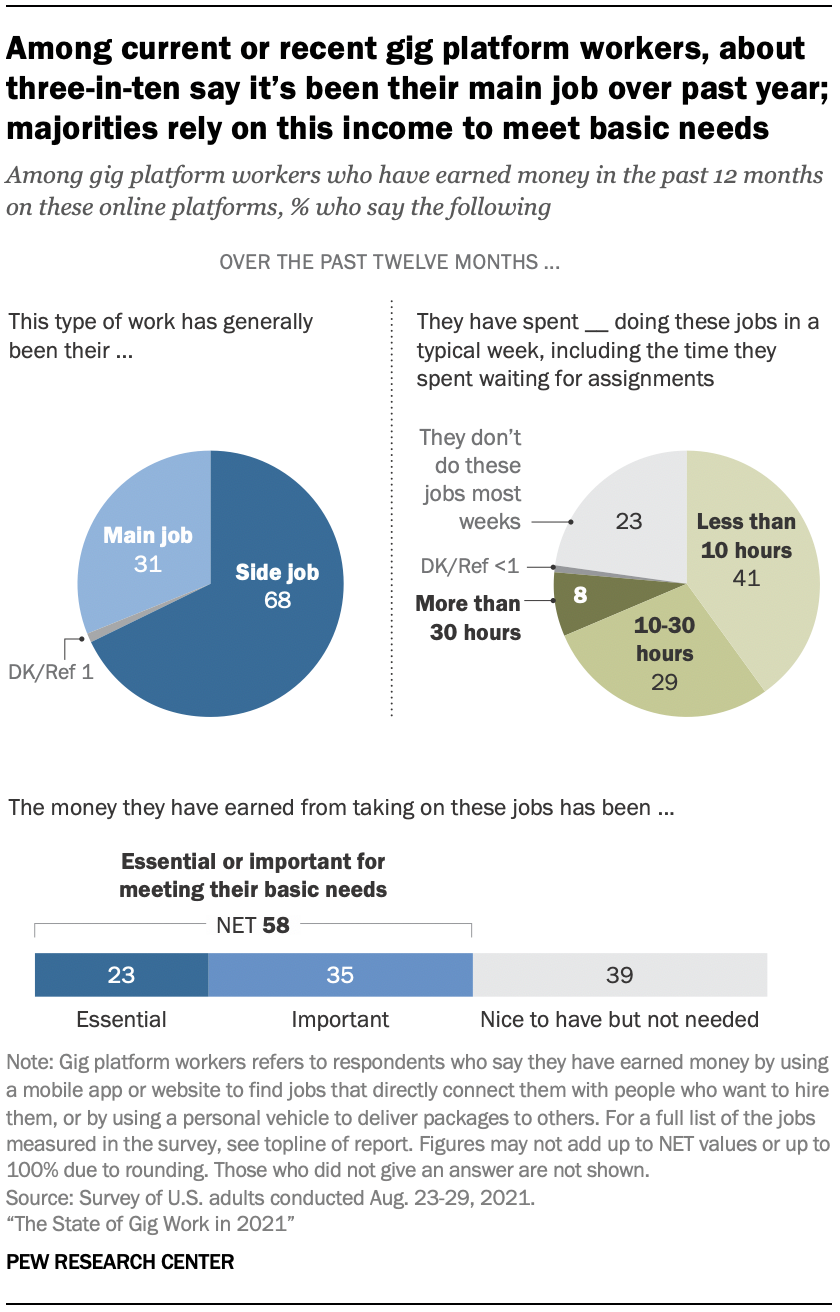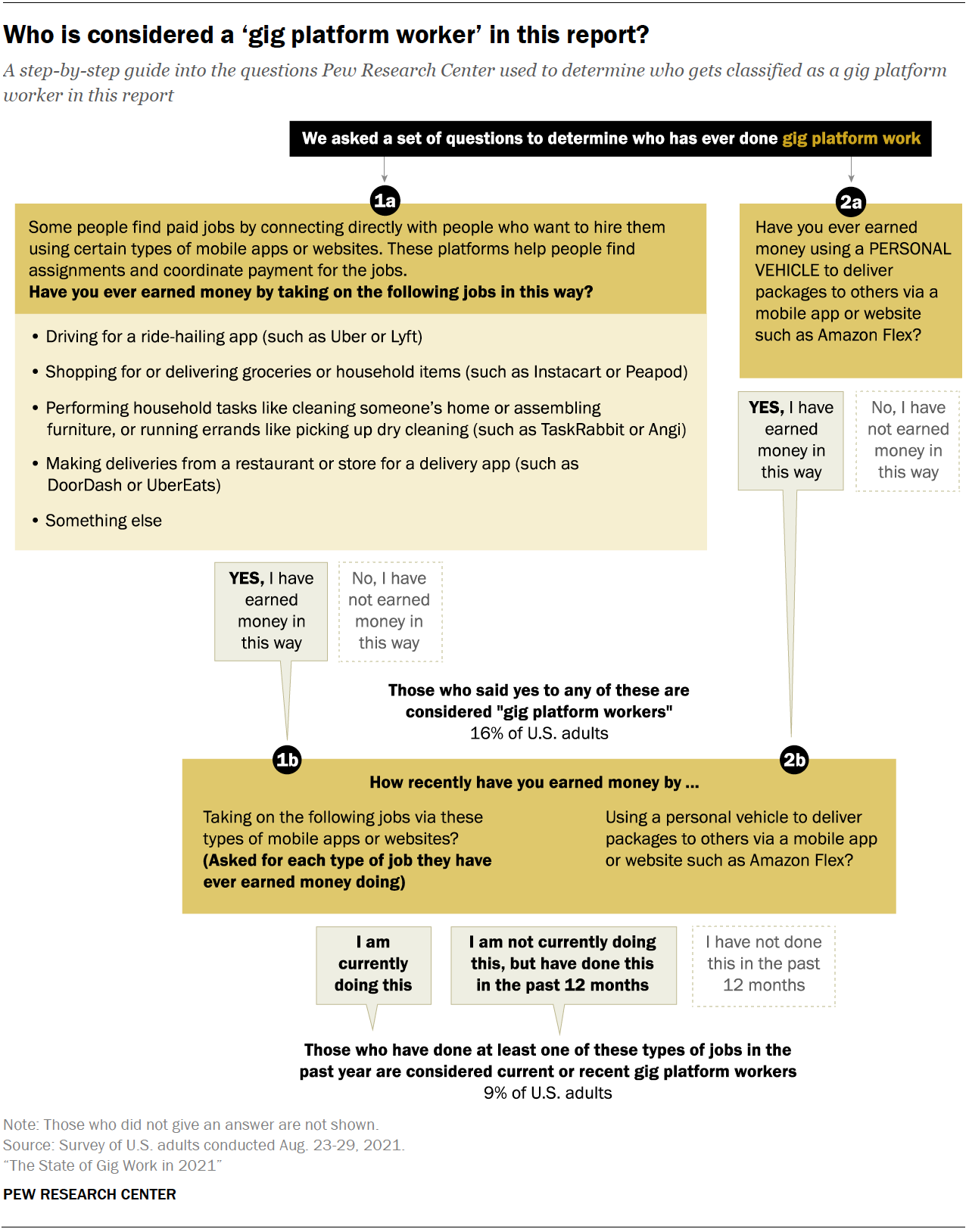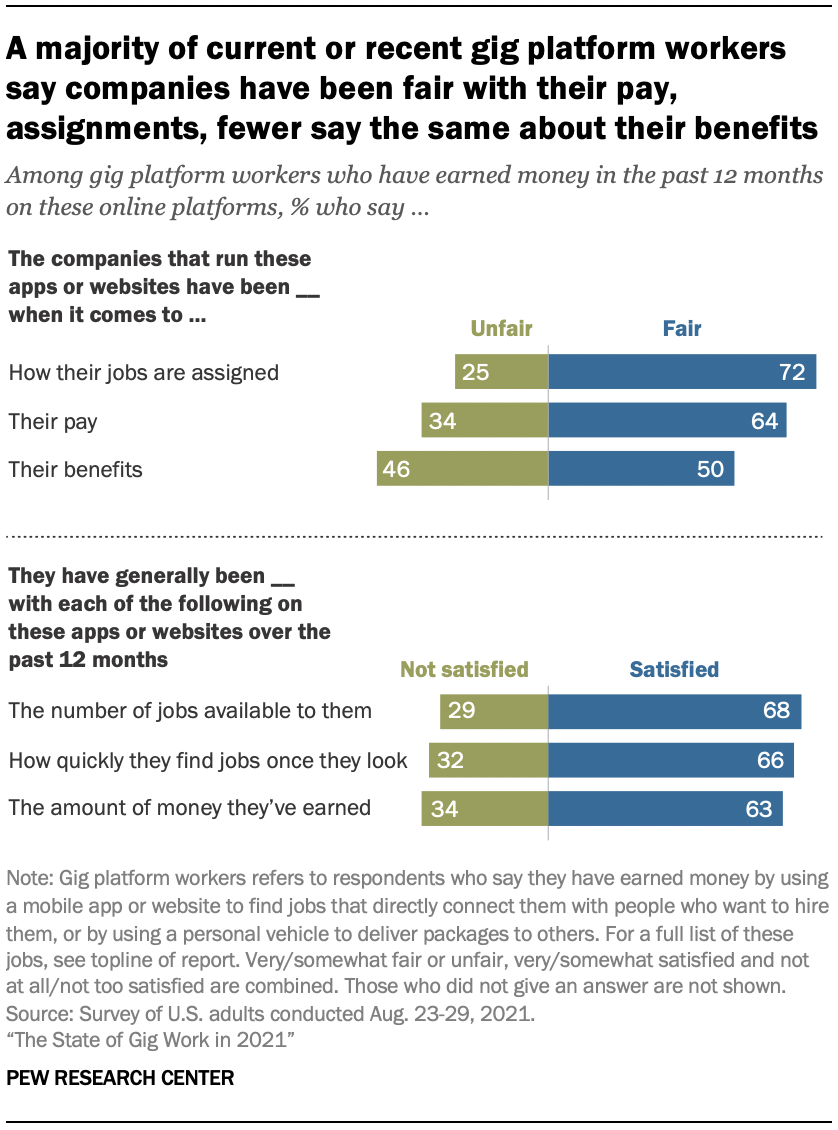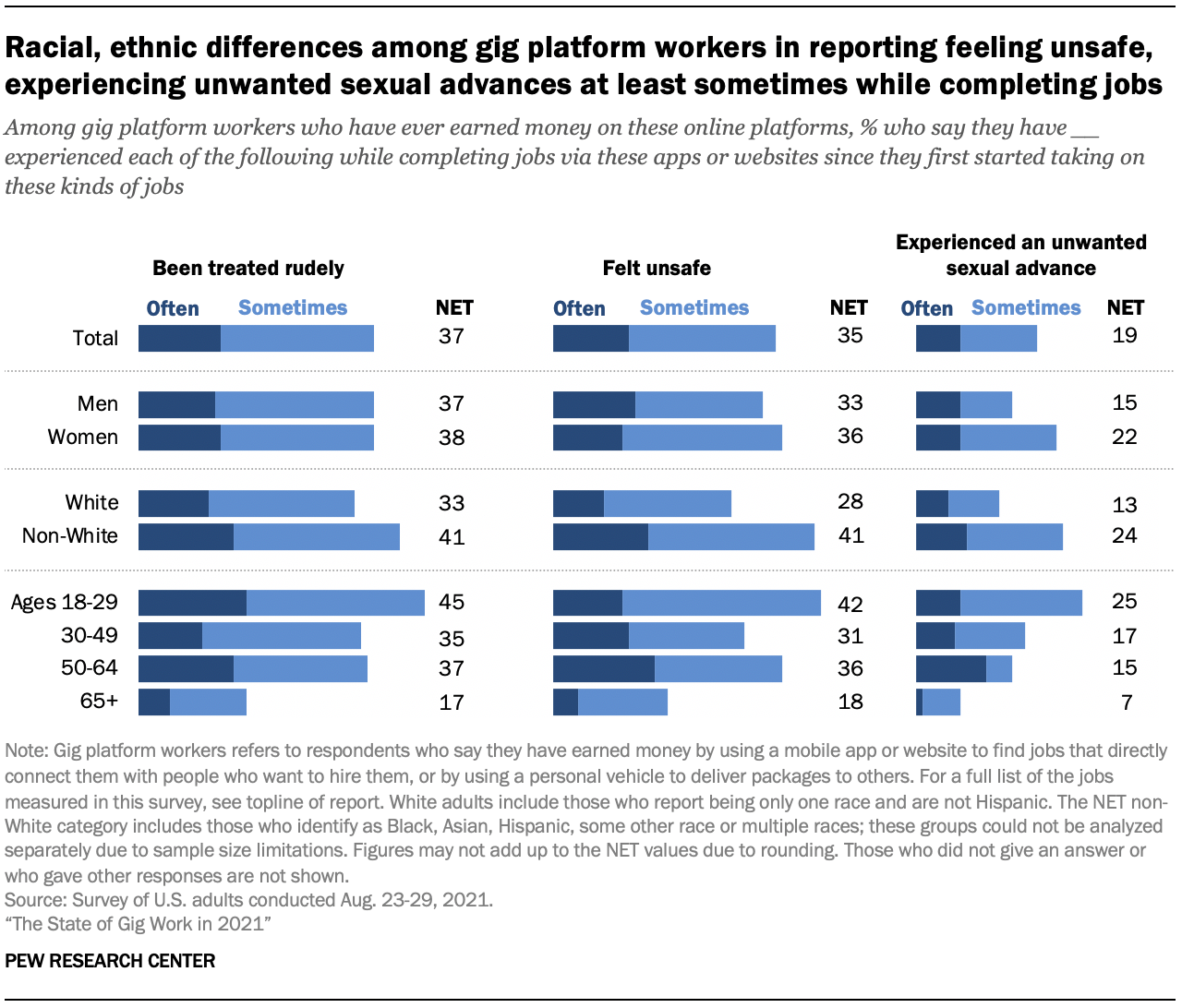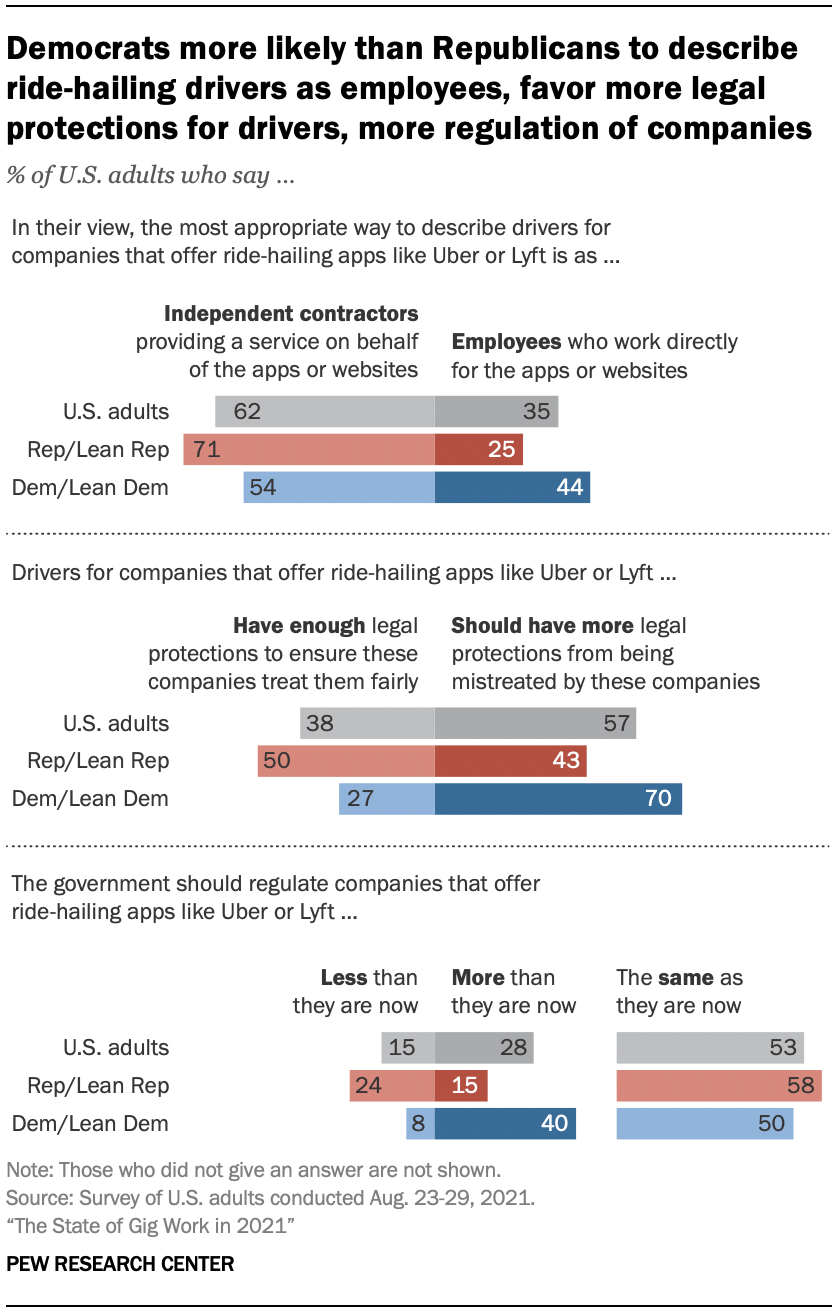16% of Americans have ever earned money from an online gig platform. While most gig platform workers say they have had a positive experience with these jobs, some report facing on-the-job troubles like being treated rudely or sexually harassed

Pew Research Center conducted this study to understand Americans’ experiences and attitudes related to earning money from online gig platforms. For this analysis, we surveyed 10,348 U.S. adults from Aug. 23 to 29, 2021.
Everyone who took part in the survey is a member of the Center’s American Trends Panel (ATP), an online survey panel that is recruited through national, random sampling of residential addresses. This way, nearly all U.S. adults have a chance of selection. The survey is weighted to be representative of the U.S. adult population by gender, race, ethnicity, partisan affiliation, education and other categories. Read more about the ATP’s methodology.
Here are the questions used for this report, along with responses, and its methodology.
Nontraditional, short-term and contract work existed prior to the internet and smartphones, but the gig economy has ushered in a new way of connecting people with consumers and those who want to hire them. Indeed, the emergence of companies like Uber, TaskRabbit or DoorDash has expanded the way people earn money and added another dimension to the labor force.
To better understand the experiences of people who take on work through online gig platforms, Pew Research Center surveyed U.S. adults in August 2021 and found that 16% of Americans have ever earned money through an online gig platform in at least one of the following ways: driving for a ride-hailing app; shopping for or delivering groceries or household items; performing household tasks like cleaning someone’s home or assembling furniture, or running errands like picking up dry cleaning; making deliveries from a restaurant or store for a delivery app; using a personal vehicle to deliver packages to others via a mobile app or website such as Amazon Flex; or doing something else along these lines.1
Earning money through these apps or websites varies by a number of factors – most notably by age, race and ethnicity, and household income. Three-in-ten 18- to 29-year-olds have ever earned money through an online gig platform, but that share drops to 18% among those ages 30 to 49 and even smaller for those ages 50 and up.
Additionally, Hispanic adults stand out for participating in the gig labor force: 30% have ever earned money in this way, compared with 20% of Black adults, 19% of Asian adults and 12% of White adults.2 And Americans with lower incomes are more likely than those with middle or upper incomes to have ever earned money through these kinds of sites or apps.3
Some Americans have completed work via these gig platforms in the past year: 4% are currently doing these types of jobs, while an additional 5% are not currently doing this but have done so in the past year. In total, 9% of U.S. adults are current or recent gig workers, meaning they have earned money through an online gig platform in the past 12 months. And the demographic makeup of those who have done this work in the past year largely mirrors those who have ever earned money through online gig platforms.
Beyond the makeup of this workforce, the survey also highlights a variety of ways that different people rely on online gig jobs and integrate them into their lives. Among current or recent gig workers, more say the work is something they do on the side rather than their primary way of earning a living. And relatively few people who have taken on this work over the past year report putting in more than 30 hours during a typical week.
Still, there is a smaller, but notable, segment who have more fully incorporated these jobs into their work life: 31% of current or recent gig workers – representing 3% of U.S. adults overall – say this has been their main job over the past 12 months. Those shares are even higher for those who are less affluent: 42% of current or recent gig workers who have lower incomes say it has been their main job over the past year. That translates into 7% of all adults with lower incomes.
A majority of Americans who’ve earned money through a gig platform over the past year say they either spent less than 10 hours in a typical week performing these tasks or don’t do these jobs most weeks. Still, 36% say that in the past year, they clocked 10 to 30 hours (29%) or more than 30 hours (8%) doing these jobs, including waiting for assignments, in a typical week.
At the same time, some gig workers are more financially dependent on this income than others. Among current or recent gig workers, roughly six-in-ten say the money they earned through these platforms over the past 12 months has been essential (23%) or important (35%) for meeting their basic needs, while 39% say the income has been nice to have, but not needed.
While proponents praise the gig economy for its flexibility and fueling a sense of entrepreneurship, others have been openly critical about the lack of benefits and job security that can be associated with these jobs. This struggle has played out across the country with advocates, lawmakers and gig companies debating the legal status of gig workers.
Many of these discussions have centered around one particular type of gig job: ride hailing. When asked what is the most appropriate way to classify drivers for ride-hailing companies, the public is more likely to say “independent contractor” rather than “employee.” Beyond the debate around classification, there is majority support for better protections for drivers: 57% of Americans think those who drive for ride-hailing companies deserve greater legal protections from being mistreated.
These are some of the key findings from a survey by Pew Research Center, conducted Aug. 23-29, 2021, among 10,348 U.S. adults on the Center’s nationally representative American Trends Panel (ATP).
Finances, flexibility key reasons people turned to gig platform work over the past year; but motivations vary by how financially reliant people are on these jobs
Gig jobs are often billed as a good way to generate more income and control when and how much you work. These sentiments are similarly expressed by gig workers in this survey.
When asked why they are drawn to these jobs, gig workers are especially likely to cite financial reasons as key factors – either for saving up or covering fluctuations in income. Among current or recent gig workers, about half or more cite wanting to save up extra money (56%) or needing to cover gaps or changes in their income (52%) as major reasons for taking on these jobs over the past 12 months.
The ability to set their own hours also ranks highly among those who have earned money via gig jobs in the past year: 49% say being able to control their own schedule is a major reason why they have taken on these jobs over the past year. Smaller shares cite wanting to be their own boss, doing this for fun or to have something to do in their spare time, or not having many other job opportunities in their area as major reasons why they have earned money through these platforms in the past year.
Motivations vary between those who rely heavily on the money they earn through these platforms and those who do not. Current or recent gig workers who describe this money as essential or important are more likely than those who are less financially reliant on these jobs to cite covering gaps or changes in their income (61% vs. 38%), wanting to be their own boss (44% vs. 22%) or not having other job opportunities in their area (34% vs. 21%) as major reasons for doing this work in the past 12 months.
About two-thirds of current or recent gig platform workers think companies that run these platforms are fair when it comes to their pay, but smaller shares say the same for benefits
By and large, gig platform workers view their experience with earning money through these platforms in positive rather than negative terms. And among those who’ve done this work in the past year, majorities say they are at least somewhat satisfied with the number of jobs available to them, how quickly they can find jobs and the amount of money they’ve earned over the past 12 months.
When it comes to perceptions of fairness, 72% of current or recent gig workers say the companies that run these apps or sites have been at least somewhat fair when it comes to how their jobs are assigned, while 64% say the same about their pay.
By comparison, these workers are more critical of the way companies have handled their benefits. Nearly half of recent or current gig workers (46%) say companies have been unfair when it comes to their benefits, while half believe they have been fair. These sentiments seem to dovetail with broader criticism of the gig economy – that gig work does not adequately address issues around unemployment, healthcare and paid leave benefits.
Some gig platform workers report harassment, safety and COVID-19 concerns
There are some workers who have experienced the more negative sides of gig platform jobs from being harassed to feeling unsafe. Some 37% of those who have ever earned money in this way say they have been treated rudely at least sometimes while doing these jobs, with 13% saying this happens often. A similar share (35%) say they have often or sometimes felt unsafe while completing these jobs. Some workers are also targets of sexual harassment: About one-in-five say they have often (7%) or sometimes (12%) experienced unwanted sexual advances while completing jobs.
These encounters are particularly common among certain groups. Gig workers who do not identify as White are more likely than those who do identify in this way to say they have felt unsafe or experienced an unwanted sexual advance on the job at least sometimes.4 Experiences also vary by age: Gig workers ages 18 to 29 are more likely than those ages 30 and older to say they have at least sometimes been treated rudely (45% vs. 33%), felt unsafe (42% vs. 31%) or experienced an unwanted sexual advance (25% vs. 15%).
Among gig workers, there are no statistically significant differences by gender with encountering rudeness or feeling unsafe, but women are more likely than men to say they have often or sometimes faced unwanted sexual advances while completing jobs (22% vs. 15%).
People who have earned money through gig jobs that require contact with the public have also faced risk of exposure to COVID-19 – prompting some to strike or leave the platforms. The findings in this survey reflect those fears: About half of current or recent gig workers say they have been very (15%) or somewhat (36%) concerned about getting the coronavirus while completing these jobs in the past year. And these shares vary by race and ethnicity, with 59% of non-White current or recent gig platform workers reporting being at least somewhat concerned about catching COVID-19 while doing this work over the past 12 months, compared with 38% of those who are White.
Majority of Americans say ride-hailing drivers are most appropriately described as independent contractors, not employees
Debates around how ride-hailing companies should be regulated by the government and what protections their drivers should have are heating up at the federal, state and municipal levels. A key consideration in many of these discussions is whether drivers should be classified as employees or independent contractors.
This survey asked Americans for their views on this issue – and a majority (62%) say the most appropriate way to describe ride-hailing drivers is as independent contractors providing a service on behalf of the apps or websites. Smaller shares (35%) say these drivers are best described as employees who work directly for these platforms.
While a minority of Americans view these drivers as employees regardless of political affiliation, the balance in views varies by party. Democrats and those who lean toward the Democratic Party are more likely than Republicans and GOP leaners to say drivers are most appropriately described as employees – a 19 percentage point difference.
Gig platform workers’ self-perceptions follow a similar pattern – 65% see themselves as independent contractors, while 28% view themselves as employees. And views by political party follow a similar pattern as the general population – Democratic gig workers are more likely than their Republican counterparts to think of themselves as employees (33% vs. 23%).
When it comes to other ride-hailing policy matters, the survey finds Americans prefer the status quo regarding government involvement in regulating these companies – even as a majority think these drivers need more legal safeguards. Some 57% of Americans say drivers for ride-hailing apps should have more legal protections from being mistreated by their companies; while 38% say these drivers have enough legal protections to ensure these companies treat them fairly. At the same time, though, half of Americans (53%) do not support changes in government regulation – they say the government should regulate companies that offer ride-hailing apps such as Uber or Lyft the same as they are now. Some 28% favor more regulation, while 15% say they should be regulated less than they are currently.
Just as with driver classification, views vary by political party. Democrats are more likely than Republicans to say drivers need more legal protections from mistreatment by their companies and to support more government regulation of ride-hailing companies.
